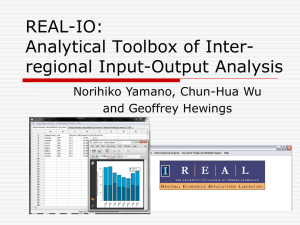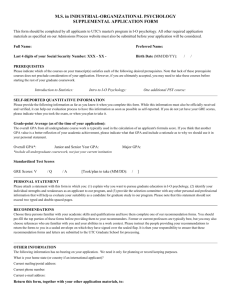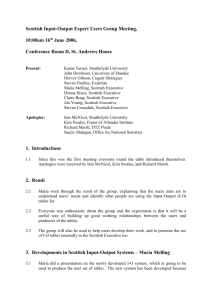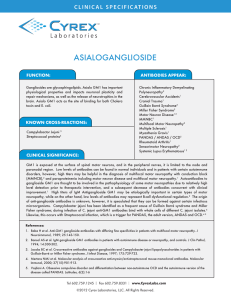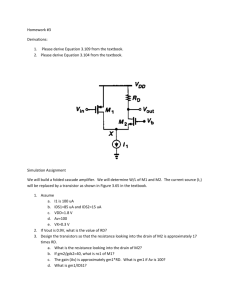GTAP Resource 757
advertisement
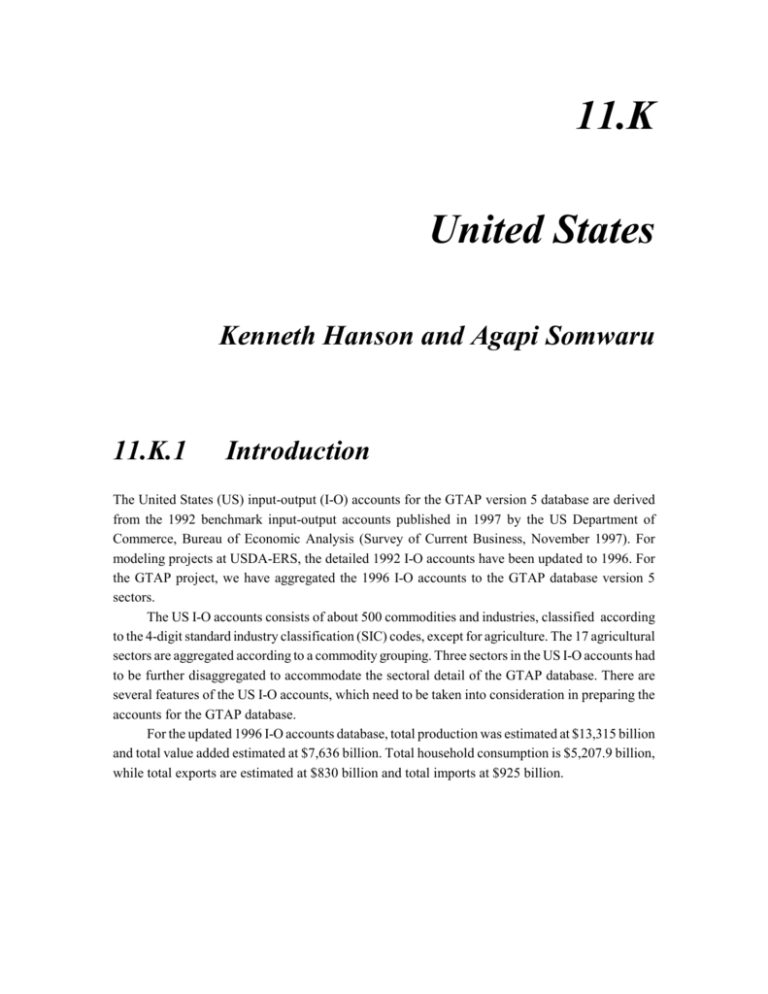
11.K United States Kenneth Hanson and Agapi Somwaru 11.K.1 Introduction The United States (US) input-output (I-O) accounts for the GTAP version 5 database are derived from the 1992 benchmark input-output accounts published in 1997 by the US Department of Commerce, Bureau of Economic Analysis (Survey of Current Business, November 1997). For modeling projects at USDA-ERS, the detailed 1992 I-O accounts have been updated to 1996. For the GTAP project, we have aggregated the 1996 I-O accounts to the GTAP database version 5 sectors. The US I-O accounts consists of about 500 commodities and industries, classified according to the 4-digit standard industry classification (SIC) codes, except for agriculture. The 17 agricultural sectors are aggregated according to a commodity grouping. Three sectors in the US I-O accounts had to be further disaggregated to accommodate the sectoral detail of the GTAP database. There are several features of the US I-O accounts, which need to be taken into consideration in preparing the accounts for the GTAP database. For the updated 1996 I-O accounts database, total production was estimated at $13,315 billion and total value added estimated at $7,636 billion. Total household consumption is $5,207.9 billion, while total exports are estimated at $830 billion and total imports at $925 billion. 11-K-2 11.K.2 Use and Make Tables The US I-O accounts are in the form of a Make and Use table, with commodities distinguished from industries. The GTAP database has the orientation of a commodity by commodity transaction table. The Use table provides information on the use of commodities by industries as well as 40 components of final demand (consumption, investment, inventory change, exports, imports, plus 35 federal, state and local government agencies). Imports are a vector of data by commodity. There are also three components of value added by industry (employee compensation, indirect business tax, and other value added). The Make table provides information on industry production of commodities. If there were a one-for-one correspondence of commodities and industries the Make table would be diagonal, and the Make and Use tables would simply collapse to a single transactions matrix of either commodity by commodity or industry by industry orientation. Since the table is not diagonal, we transform the Make and Use tables into a commodity by commodity transactions matrix for the GTAP database. 11.K.3 Import Ridden Use Table Intermediate and final demands are for commodities sold in domestic markets, which are a composite of imports and domestically produced goods. One way to think about this structure of the Use table is that imports are mixed with domestic goods in a warehouse at the border, and domestic demand is for the composite commodity. In this way, data on imports are maintained as a single dimensioned array of commodity imports. This composite commodity treatment of imports in the US I-O accounts is different from the treatment of imports in the GTAP database, where intermediate and domestic final demands are decomposed into a demand for imported and a demand for domestically produced goods sold on domestic markets. To accommodate the GTAP database framework, we separated imports from domestic goods in the Use table of the US I-O accounts. We accomplished this by assuming each user of a composite commodity uses the same share of domestic goods and imports. Unpublished data underlying the US I-O accounts could have provided information for a more suitable decomposition of domestic demand for a composite commodity into imports and domestic goods. Given the time and resource limitations we did not explore the use of the unpublished worksheets underlying the published I-O accounts. 11-K-3 11.K.4 Transactions in Producer Prices Data on trade and transportation costs exists for each transaction allowing all components of demand (intermediate, domestic final demand, and exports) for each commodity to be expressed in purchaser prices as well as producer prices. Hence, a choice in the treatment of trade and transportation costs has to be made. One approach is to use commodity demand in producer prices. This way each user of a commodity also has a demand for trade and transportation services. Another approach is to treat trade and transportation services as margins on the demand for each commodity by each component of demand, an approach of commodity demand in purchaser prices. We have chosen to express the value of exports in the US I-O accounts in producer prices so that these export values are made consistent with the GTAP trade database. 11.K.5 Treatment of Value Added by Industry Value added data are divided into three components, employee compensation, indirect business tax, and other value added. Other value added consists of proprietors income, net interest, corporate profits, capital consumption allowance, rental income, business transfer payments, and current surplus of government enterprises. The other value added vector thus can be considered as the return to proprietors, capital, and land. One issue is the inclusion of all proprietors income in other value added. Other value added is the return to capital and land in the GTAP model, so all proprietors income will be treated as a return to capital plus land. Some proprietors income is a return to the proprietors’ labor. To make this adjustment, we add an imputed return to proprietors’ labor to the employee compensation component of value added, and subtract it from other value added.1 Proprietors’ labor is a significant share of labor in agriculture, making this an important adjustment for the returns to agricultural labor in the GTAP database. Another adjustment to other value added, important for the returns to capital and land in agriculture, is the treatment of the returns to non-operator landlords. In the I-O accounts they are an intermediate cost to agriculture, going to the real estate sector. We remove these as an intermediate cost and treat the $15.5 billion of returns to non-operator landlords as a part of other value added. 1 A potential problem with other value added is that it may be negative for specific industries. For 1992 and 1996, other value added is positive, even after adjusting for labor's share of proprietors income. 11-K-4 11.K.6 Treatment of Tariffs A final issue relates to the treatment of tariffs in the US I-O accounts, and making this compatible with the requirements of the GTAP database. In the US I-O accounts, total tariffs are treated as a positive import by the wholesale trade sector, while the negative commodity import data are tariff ridden. Total tariffs are also included as part of the wholesale trade sector’s indirect business tax (part of value added). We remove the total tariff value from the wholesale trade sector of the import data and the indirect business tax data. For consistency, we also remove total tariffs from the wholesale trade sector of the Make table prior to creating the Transactions table. Tariffs by commodity are also provided separately as part of the US data in the GTAP database. They are from the Bureau of Census Trade Data Files. The tariff data are adjusted to equal the total tariff value in the I-O accounts. The data on imports remain tariff ridden. 11.K.7 Special Industries in US I-O Accounts To maintain a consistent definition of GDP in both the I-O accounts and the National Income and Product Accounts, six special industries are included in the I-O accounts. When aggregating these special sectors into the sectors of the GTAP database, some of them may cause data problems, such as negative numbers, distorted sectoral cost structures, or distorted structure of demand. To clarify the potential problems, we discuss these special sectors in detail and where they are included in the GTAP sector aggregation. These special sectors are: — noncomparable imports, — scrap, used, and secondhand goods, — general government industry; — rest of the world adjustment to final uses, — household industry, and — inventory valuation adjustment. Noncomparable imports (I-O sector 800000) are imports used by industry and domestic final demand but have no corresponding domestic commodity. The treatment of noncomparable imports has changed with the 1992 I-O Accounts. They no longer include domestically consumed imported goods, such as bananas and coffee for the United States. They consist of goods purchased by U.S. 11-K-5 residents abroad and of service imports with no domestic counterparts, such as port expenditures by U.S. airlines in other countries. In 1996, we estimate noncomparable imports to be $113 billion, with $39 billion consumed by U.S. households traveling or living abroad, $12 billion used by the government, and $62 billion used as intermediate goods by industry. We aggregate noncomparable imports into the public administration sector (OSG), making it appear to have a large import to domestic supply ratio. Scrap, used, and secondhand goods (I-O sectors 810001 and 810002) are special sectors that account for the investment component of final demand selling such goods to industry, households, government, and as exports. A potential complication with this sector is a negative investment demand (estimated to be -$40 billion in 1996), but it has not been a problem when we aggregate them into other machinery and equipment (OME). Government industry (I-O sector 820000) provides labor and capital services for government use. The return to capital is imputed to equal the capital consumption allowance for the government's capital stock. The inclusion of a return to government capital in the government industry's value added is a new feature of the 1992 I-O Accounts. We estimate the 1996 employee compensation to be $737 billion and other value added to be $129 billion. There is no intermediate demand by the industry and the only consumer of its output (labor and capital services) is the government. We aggregate the sector into the public administration sector (OSG). Rest of the world adjustment to final uses (I-O sector 830001) is an adjustment to exports, personal consumption, and federal government consumption for expenditures by foreigners while in the United States. There is no value added or output associated with this sector, the final demands net to zero. In 1996 we estimate the rest of world industry export value at $85 billion, with personal consumption at -$84 billion. The negative adjustment in personal consumption accounts for the fact that the personal consumption expenditures by commodity in the IO account are by U.S. residents and by foreigners while in the United States. Exports in the I-O accounts are only those goods and services shipped outside the United States. The rest of world adjustment to consumption and exports in the I-O accounts is necessary in a GDP accounting framework, since personal consumption should only be by U.S. residents. Consumption expenditures by foreigners in the United States should be a part of exports. Rather than making the adjustment at the detailed commodity level, the I-O accounts introduce an aggregate adjustment with this special industry. Aggregating this industry with a subset of other industries will bias the export to domestic sales ratio and may create a negative personal consumption expenditure for the corresponding commodity. To avoid this problem, we have made the rest of world industry adjustment at the commodity level using data from the U.S. Travel and Tourism Satellite Accounts, eliminating the special industry [Okubo and Planting, Survey of Current Business, 78(7), July 1998, pp. 8-22]. The 1996 I-O account data provided GTAP includes this adjustment. Household industry (I-O sector 840000) provides labor services for personal consumption. When households provide labor services to other households, without going through a corporation, partnership or proprietorship then these activities are classified as occurring through the household 11-K-6 industry. Households pay employee compensation to other households for such labor services as maids, butlers, chauffeurs, and baby-sitting. In 1996, we estimate this industry at $11 billion of employee compensation, and aggregate it with the OSG sector in GTAP. Inventory valuation adjustment (I-O sector 850000) is an adjustment to other value added and to the change in business inventories component of final demand. The adjustment accounts for differences in prices used to measure the change in inventories during the year, as reported in corporate profits versus the NIPA. For 1996, the inventory valuation adjustment is -$5 billion. If this sector is aggregated into another subset of sectors it will lower the returns to capital in that aggregate sector. To avoid this bias, we remove it from the 1996 I-O accounts and SAM database. 11.K.8 Negative Values in Final Demand Except for inventory change, the GTAP database expects positive values for all commodities for each component of final demand. There are two reasons that negative final demands may occur in the I-O accounts. One is from the special sectors as discussed above, but we have treated these special sectors in a way that they do not lead to negative final demands in the US GTAP database. Another source of negative final demands is negative government expenditures. They occur when the government provides a good or service, or where they receive a rental payment from an industry when using government assets. Examples are the forestry sector, various mining sectors (gas and minerals), and a number of service sectors related to health care, education, recreation, and food services provided by the government. Negative government demand also occurs for cereal crops in some years, when government stocks are sold. In the GTAP I-O accounts, we left these negative values in the database in expectation of an adjustment in the final release. One approach to adjusting these negative government demands is to shift them into inventory supplies. 11.K.9 Sectoral Disaggregation There are three sectors in the GTAP database that are not distinguished in the US I-O accounts. This requires further disaggregation using additional data. This occurs for: i) Rice and wheat in the food grains sector; ii) Wool and other livestock products in the miscellaneous livestock sector; and iii) Crude petroleum and natural gas in a combined mining sector. We made an adjustment to the I-O accounts to separate these commodities into separate sectors. For the agricultural commodities, we used data from the Agricultural Census. The split of crude petroleum and natural gas was from Census of Manufactures data. In all three cases, the cost 11-K-7 structures for producing the separated commodities are the same. Unpublished worksheet data underlying the I-O accounts could be used to separate the cost structures for the commodities. 11.K.10 Updating the US I-O Accounts to 1996 The U.S. I-O accounts are revised once every five years, the last being for 1992, published in November 1997. For USDA-ERS modeling projects, we have updated the I-O accounts to 1996. Updating the I-O accounts, involves assembling data for the more recent year from a number of sources, and adjusting the missing data with certain computational procedure. The choice of data to assemble from published sources and data to derive by computation characterizes the different methods of updating. A basic issue is whether to use a matrix adjustment procedure (such as RAS) for adjusting the intermediate use matrix in the I-O accounts, or whether to keep the 1992 benchmark I-O coefficients. It is our preference to not use data on industry production and value added and adjust the intermediate use matrix for consistency. The reason is that the resulting adjustment will be due to both real structural change, and differences in the measurement of I-O industry activity and industry activity in the data used for updating. There is too much uncertainty about the comparability of the data and adjusted IO coefficients. As an alternative procedure for updating the I-O accounts we assemble data on final demand by I-O commodity, assume fixed I-O coefficients and industry value added to production coefficients, and use an I-O multiplier type calculation for industry production and commodity output. Changes in final demand by commodity for each component of demand drives the updating procedure. Stable I-O coefficients over a five- year period reflect the fact that intermediate demand is based on the capital technology used in an industry which does not change too rapidly. The value added coefficients (ratio to industry production) are adjusted for aggregate productivity changes. The updating procedure captures the structural changes in demand, but assumes away structural change in production technology. Data on final demand by commodity for each component of final demand are available, making this procedure operational. Data from various NIPA tables are used with other data, and US I-O account bridges from NIPA tables to I-O sectors for several components of final demand. For household consumption we use data from NIPA table 2.4 and the US I-O account bridge table D. For fixed investment, we use data on equipment investment from NIPA table 5.8 and the US I-O account bridge table E. We use NIPA table 5.6 to guide the revision of construction sectors in the I-O account for fixed investment in structures. Adjustment to inventory change in the I-O account is guided by the NIPA table 5.10. Government fixed investment is adjusted with data from the NIPA 11-K-8 table 5.14. Government consumption expenditures are adjusted using data from NIPA table 3.7. For exports and imports, we use Bureau of Census trade data by SIC and map those to the detailed I-O sectors and make some adjustments for consistency with NIPA table 4.3. 11-K-9 Appendix Table 11.K.A1 Aggregation Mapping for 1992 US I-O Sectors to GTAP Sectors GTAP Sectors Paddy rice Wheat Other grains Vegetables, fruit Oil seeds Sugar cane Plant-based fibers Other crops Cattle, sheep Animal products Raw milk Wool Forestry Fishing Coal Oil Gas Other minerals Cattle, sheep meat Other meat Vegetable oils Dairy products Processed rice Sugar Other food Beverages, tobacco Textiles Wearing apparel Leather products Wood products US I-O Sector Codes* empty (020201) (020202) (020401, 020402, 020501) (020600) (020502) (020100) (020203, 020300, 020503, 020701, 020702) (010301) (010200, 010302) (010100) empty (030001) (030002) (070000) empty (080001) (050001, 060100, 060200, 090001, 090002, 090003, 090004, 100000) (140101, 142700) (140102, 140105) (142400, 142500, 142600) (140200, 140300, 140400, 140500, 140600) (141600) (141900) (140700, 140800, 140900, 141000, 141100, 141200, 141301, 141302, 141401, 141402, 141403, 141501, 141502, 141700, 141801, 141802, 141803, 142002, 142004, 142005, 142800, 142900, 143000, 143100, 143201, 143202) (142101, 142102, 142103, 142104, 142200, 142300, 150101, 150102, 150103, 150200) (160100, 160200, 160300, 160400, 170100, 170600, 170700, 170900, 171001, 171100, 190100, 190200, 190301, 190302, 190303, 190304, 190305, 190306) (180101, 180102, 180201, 180202, 180203, 180300, 180400) (330001, 340100, 340201, 340202, 340301, 340302, 340303, 340304, 340305) (200100, 200200, 200300, 200400, 200501, 200502, 200600, 200701, 200702, 200703, 200800, 200901, 200903, 200904, 210000, 220101, 220102, 220103, 220200, 220300, 220400, 230100, 230200, 230300, 230400, 230500, 230600, 230700) contd 11-K-10 Table 11.K.A1 Aggregation Mapping for 1992 US I-O Sectors to GTAP Sectors (continued) GTAP Sectors Paper, publishing Petroleum Chemicals, rubber Mineral products Ferrous metals Other metals Metal products Motor vehicles Transport equipt Electronic equipt Machinery, equipt Other manufactures Electricity Gas distribution Water Construction Trade Other transport Water transport Air transport Communication US I-O Sector Codes* (240100, 240400, 240500, 240701, 240702, 240703, 240705, 240706, 240800, 250000, 260100, 260200, 260301, 260302, 260400, 260501, 260601, 260602, 260700, 260802, 260803, 260806) (310101, 310102, 310103, 310200, 310300) (270100, 270201, 270202, 270300, 270401, 270402, 270403, 270404, 270405, 270406, 280100, 280200, 280300, 280400, 290100, 290201, 290202, 290203, 290300, 300000, 320100, 320200, 320300, 320400, 320500, 320600) (350100, 350200, 360100, 360200, 360300, 360400, 360500, 360600, 360701, 360702, 360800, 360900, 361000, 361100, 361200, 361300, 361400, 361500, 361600, 361700, 361900, 362000, 362100, 362200) (370101, 370102, 370103, 370104, 370105, 370200, 370300, 370401, 370402) (380100, 380400, 380501, 380600, 380700, 380800, 380900, 381000, 381100, 381200, 381300, 381400) (390100, 390200, 400100, 400200, 400300, 400400, 400500, 400600, 400700, 400800, 400901, 400902, 410100, 410201, 410202, 410203, 420100, 420201, 420202, 420300, 420401, 420402, 420500, 420700, 420800, 421000, 421100) (590301, 590302, 590100, 590200) (600100, 600200, 600400, 610100, 610200, 610300, 610500, 610601, 610603, 610700) (510102, 510103, 510104, 510400, 560100, 560200, 560300, 560500, 570100, 570200, 570300) (430100, 430200, 440001, 440002, 450100, 450200, 450300, 460100, 460200, 460300, 460400, 470100, 470200, 470300, 470401, 470402, 470404, 470405, 470500, 480100, 480200, 480300, 480400, 480500, 480600, 490100, 490200, 490300, 490500, 490600, 490700, 490800, 500100, 500200, 500300, 500400, 520100, 520200, 520300, 520400, 520500, 530200, 530300, 530400, 530500, 530700, 530800, 540100, 540200, 540300, 540400, 540500, 540700, 550100, 550200, 550300, 580100, 580200, 580400, 580600, 580700, 620101, 620102, 620200, 620300, 620400, 620500, 620600, 620700, 620800, 620900, 621000, 621100, 630200, 630300, 130100, 130200, 130300, 130500, 130600, 130700, 810001, 810002) (640101, 640102, 640104, 640105, 640200, 640301, 640302, 640400, 640501, 640502, 640503, 640504, 640700, 640800, 640900, 641000, 641100, 641200) (680100, 780200, 790200) (680202) (680301, 680302) (110101, 110102, 110105, 110108, 110400, 110501, 110601, 110602, 110603, 110800, 110900, 120101, 120214, 120215, 120300) (690100, 690200, 720101, 720102, 720201, 720202, 720203, 720204, 720205, 720300, 750001, 750002, 750003) (650100, 650200, 650301, 650302, 650600, 650701, 650702, 680201) (650400) (650500) (660100, 660200, 670000) contd 11-K-11 Table 11.K.A1 Aggregation Mapping for 1992 US I-O Sectors to GTAP Sectors (continued) GTAP Sectors Financial services Insurance Business services Recreatl services Education, health Dwellings US I-O Sector Codes* (700100, 700200, 700300, 730301, 730302, 730303) (700400, 700500) (710201, 710202, 730101, 730102, 730103, 730104, 730106, 730107, 730108, 730109, 730111, 730112, 730200) (740000, 760101, 760102, 760201, 760202, 760203, 760204, 760205, 760206) (040001, 040002, 770100, 770200, 770301, 770303, 770304, 770305, 770401, 770402, 770403, 770501, 770502, 770503, 770504, 770600, 770700, 770800, 770900, 780100, 780500, 790100, 790300, 800000, 820000, 830001, 840000, 850000) (710100) * See Survey of Current Business, November 1997, for US I-O Sector Codes


